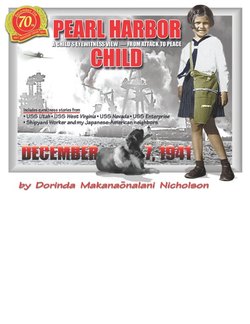Читать книгу Pearl Harbor Child - Dorinda MD Nicholson - Страница 7
На сайте Литреса книга снята с продажи.
1—My Family Moves to Pearl Harbor
ОглавлениеHow I would beg for "Just one more story, please Mom! One more Hawaiian legend, please?" I loved the ones about the fire goddess Pele and her youngest sister Hi'iaka, and especially those about Laka, the hula goddess. Mom was a kumu hula (teacher of Hawaiian dance) and so I often asked her about hula legends and any others that she would tell me.
One day, she told me the legend of the Little Yellow Shark that lived in the Bay of Pu’uloa. She also told me about the shark goddess, Ka’ahupahau, who lived in the same bay full of pearl oysters which is called Pearl Harbor. That’s when I first learned that we would be moving to the Pearl City Peninsula, a small strip of land surrounded on three sides by the waters of the Bay of Pu’uloa, better known as Pearl Harbor.
Our house was at 443 Jean Street in the area called Pearl City Peninsula. It was so close to the harbor that Mom could walk to her new job at the Pan American World Airways Clipper Base. She could come home on work days for lunch with my baby brother, Ishmael and our dog, Hula Girl. I was away in kindergarten at Sacred Hearts Convent, and Dad was at work at the Honolulu Post Office. The year was 1940.
In those days, children and their parents who came to Hawai’i by airplane flew directly to Pearl Harbor’s waters and landed right on the water in a seaplane. The seaplanes, called “China Clippers,” looked like flying boats, with four enormous propellers. After the seaplane landed, it would taxi up to a pier just like a motorboat. It would anchor just like a boat, and the passengers would get off onto a rough wooden dock. Mom could clearly see the seaplanes in the harbor from her desk in the library of the Pan American World Airways offices.
To be a child of the harbor was special. My friends and I would take our nets down to the piers where the airplanes were moored, and drop them into the shiny water to catch crabs. The best bait was fish heads, and we tied them to the center of the circular net to lure the crabs. I wanted the best bait, aku heads, so I could attract the most crabs, and especially Samoan crabs, which were the largest of all.
In the fall of 1941, I began first grade at Sacred Hearts Convent in Nu’uanu. But I wouldn’t finish out the year there, because of events that were beyond my control, even beyond imagining!
Meanwhile, somewhere in the Pacific Ocean, the ships of Japanese Admiral Nagumo’s Kido Butai (striking force) were making their way eastward through heavy weather and tossing wintry seas toward the Hawaiian Islands.
In that armada, six aircraft carriers provided a portable airfield for 353 bombers, torpedo planes and Zero fighters. Their deadly mission—to attack the American fleet, peacefully anchored in Pearl Harbor a few hundred yards from my home!
